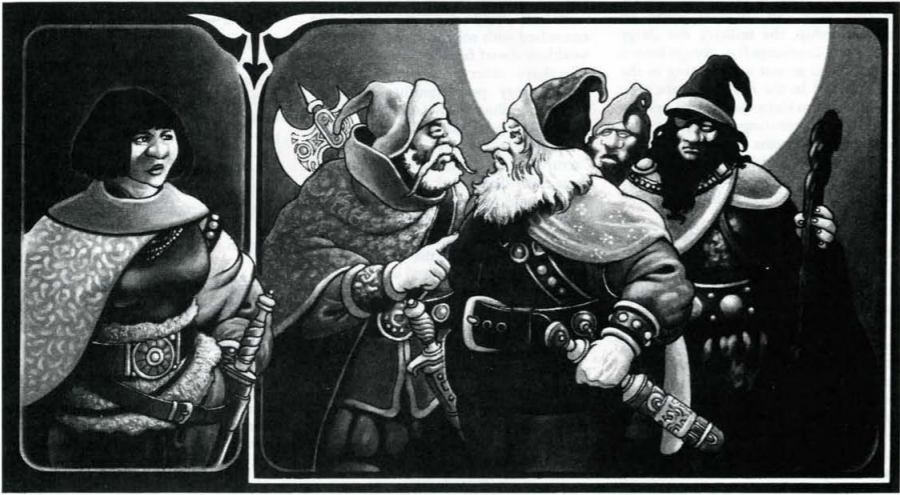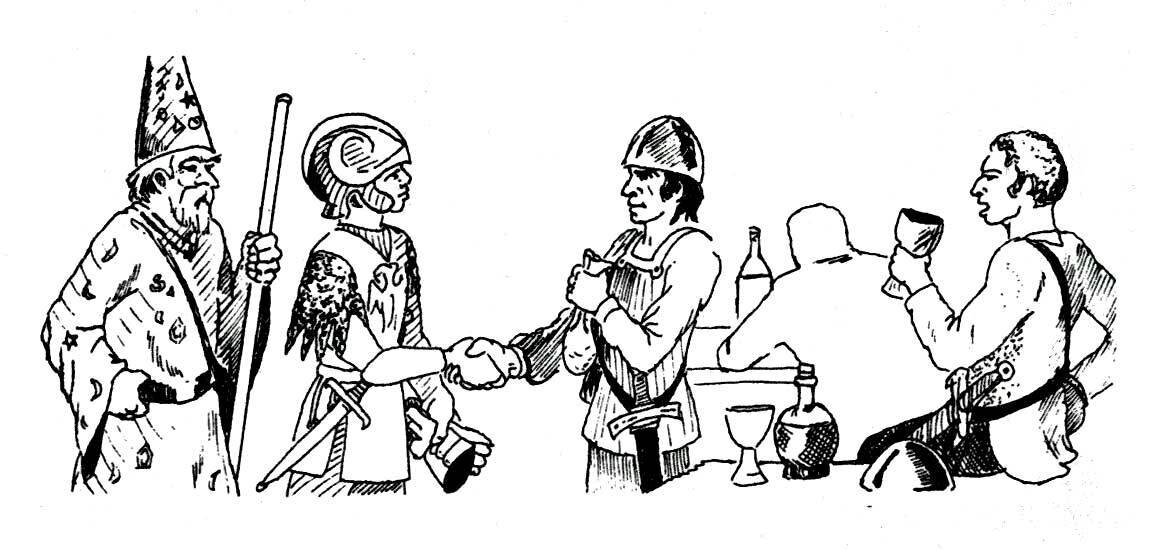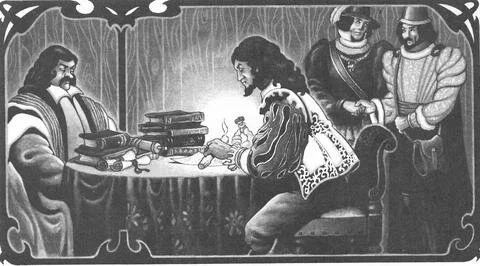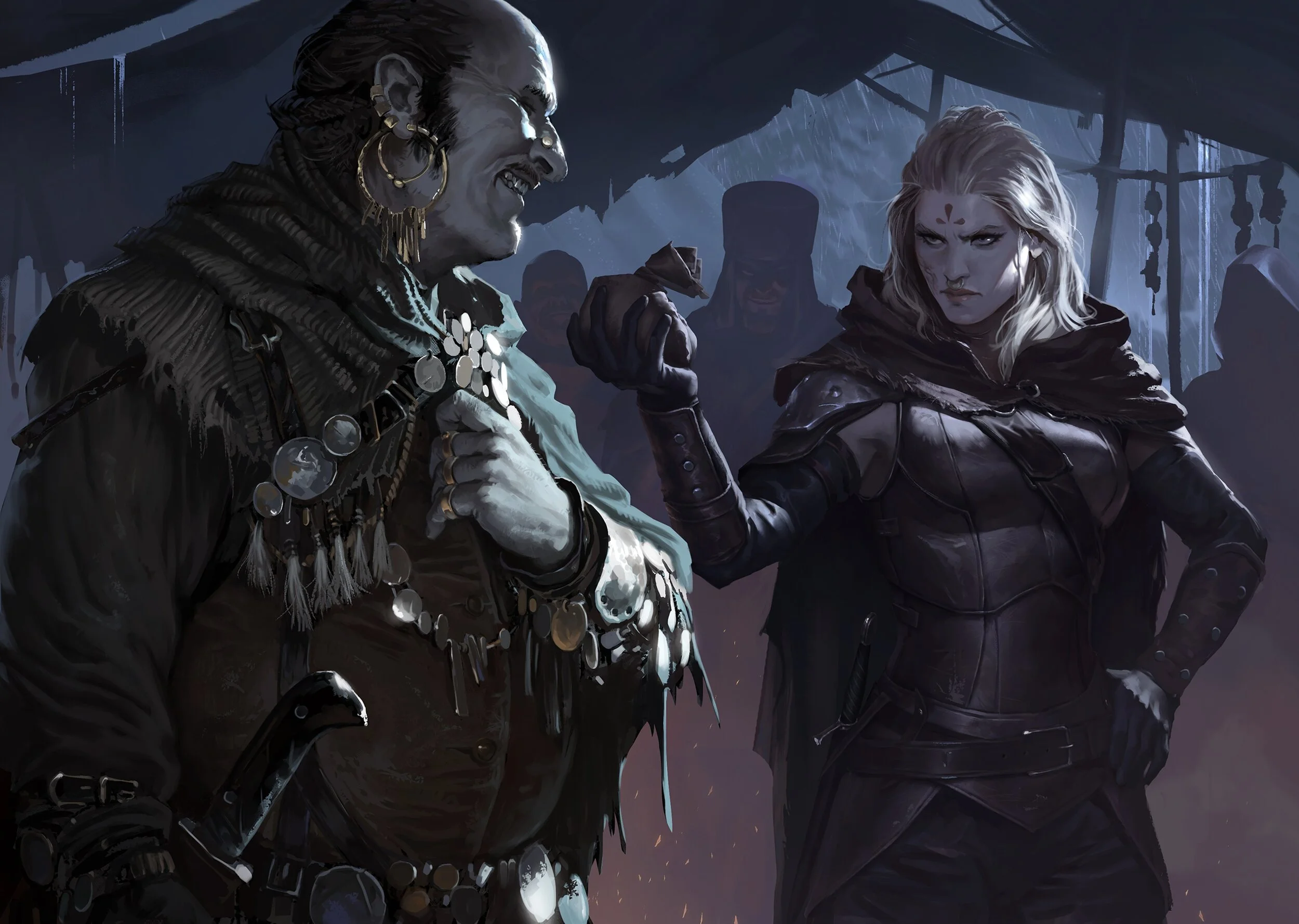Hostile Negotiations: A Framework for Social Combat
The complaint often leveled at all manner of D&Ds (it didn’t start with the latest edition) is that all of the focus is on combat, leaving only scraps for its ugly step-siblings, exploration and social interaction. This is simultaneously a fair complaint (because, well, it’s true) and an unfair one (the unequal weight in the rules is partially due to the high stakes of combat relative to the other modes of play). However, largely in reaction to the failings of mainline D&D, the OSR and its spawn has attempted to flesh out the other pillars of play, specifically exploration. BLANK-crawls abound: There is at present a boatload of theory on dungeoncrawls and location-based exploration, alternatives such as depthcrawls, and new modes for representing overland travel from hexcrawls to pointcrawls. Even the OSR/Post-OSR’s fascination with inventory rules, resource-management and making those aspects a vital and downright fun mode of play are in service to games with a renewed focus on exploration. But one so-called pillar remains unloved: social interaction.
It is easiest to not design rules for social interaction because it is most easily run without rules. It involves conversations, and that’s what tabletop games are, no? The referee need only embody the NPC, the players need only stay in-character, and the game runs on thespian magic. Social interaction eludes efforts to mechanize it. The prototypical example is of a player who gives an impassioned speech in-character, pulling on every heartstring present, not a dry eye in the house. The referee, wiping away a tear, calls for a Charisma test. Nat 1. The referee is now faced with an impossible choice: adjudicate the results based on the in-character roleplaying or the mechanics. Once mechanics worm their filthy way into the pure art of roleplay, no choice truly feels right. A referee that has had anything akin to them happen likely resolves to make roleplay a separate sphere (but what of my +5 charisma? my persuasion skill? a player may object). But the error is the level at which the mechanics operate in social interaction in games.
Mechanics should not replace social interaction, it should structure it. The problem with the aforementioned example is that the player already roleplayed the interaction. The referee and other players knew how well they did based on that alone. When the referee then called for a stat test, it was duplicative of that effort. Instead, what the referee should want is a rubric, some structure against which to neutrally adjudicate success or failure based on the fiction that just occurred. The reason for some structure is to avoid an entirely arbitrary game of make-believe or mother-may-I, where the player succeeds only when the referee says so, based on nothing more than capricious intuition. It is undoubtable that some referees can be absolutely neutral arbiters when determining how their NPCs react to the player-characters’ entreaties and that any structure would be redundant to the referee’s ironclad, dispassionate objectivity. However, to such a referee, might I suggest that some structure outside your own mind is still valuable, if only to verify your stoic wisdom is, in each instance, a fair adjudication of the social situation?
Social interaction rules are hard to write. For combat, exploration and inventory, rules can be foregrounded, a visible scaffolding that facilitates the fiction. For social interaction, you must be wary of overpowering the soft, fragile roleplay at its core with vulgarities such as dice, math and numbers, lest you frighten the roleplay away altogether. In my first attempt at social interaction rules, I did just that. I took the same framework I previously applied to lockpicking and hacking and applied it to social interactions. This is essentially a rock-paper-scissors framework and my rock, paper and scissors was logos, ethos and pathos. All well and good for a minigame for debate nerds, but this rule set was overbearing. In the end, it mattered less how well the player negotiated or how well-suited the argument to convince the NPC of the topic at hand. Instead, it was the type of argument being made and the order it was being made in. The player was just as well off saying “first I make a logos argument” as they were actually roleplaying it. Obviously it was back to the drawing board. After a few iterations, I landed on the rules below.
I am first going to provide some background for aspects of the Prismatic Wasteland system that are necessary for understanding the negotiation rules in context. First, in Prismatic Wasteland, there are stats (e.g., Charisma) with scores (1-20) and modifiers (-5 to +5). The scores, however, are an expendable resource. Spending points of the stat doesn’t change the modifier (it is based on the stat’s maximum rather than its current value), but going to 0 in a stat is an excellent way to die. Stats regenerate on long rests (meaning at least a week). NPCs in Prismatic Wasteland have a stat called “Mettle.” It represents the character’s willpower and determination. It ranges from a d4 (low) to a d12 (high). Brave and stubborn characters have a high Mettle; cowardly and passive characters have a low Mettle. The Mettle stat is used in the Morale rules or in determining whether followers leave when mistreated. It also plays a part in Arguments, my catch-all term for “social combat.” Other games may call it negotiations, but “social combat” is really the best conceptualization. Like combat, there are two sides (typically) competing over some contested area. Outrageous misfortune is dealt not by slings and arrows but by sharp tongues and acerbic wit. Also like combat, the parties may not argue to the death but may retreat, deciding that the other party cannot be reasoned with. When the stakes are properly aligned, social combat can also be just as dangerous. In an argument, it is necessary to determine the opposing NPC’s disposition toward the player-characters.
DISPOSITIONS
At the beginning of an argument, the referee should determine the disposition of the NPCs toward the player-characters: Hostile, Unfriendly, Indifferent, Friendly or Allied.
A Hostile NPC wishes the player-characters ill and will attack them if given an opportunity.
An Unfriendly NPC does not like the player-characters and may attack them if provoked.
An Indifferent NPC has no strong opinions about the player-characters.
A Friendly NPC likes the player-characters and will treat them with respect and admiration.
An Allied NPC admires the player-characters and will offer them reasonable support.
Hostile NPCs are typically enemies, but some enemies are merely Unfriendly or Indifferent. Allied NPCs may become a follower or a mentor to a player-character.
Determining Disposition
If an initial disposition is uncertain, one of the player-characters makes a moderate Charisma test.
On a full success, the NPC is Friendly.
On a mixed success, the NPC is Indifferent.
On a failure, the NPC is Unfriendly.
On a critical success, the NPC is Allied.
On a critical failure, the NPC is Hostile.
This test is made at advantage if the player-characters previously helped the NPC or at disadvantage if the player-characters previously fought the NPC.
After this test, any player-character who has had a positive interaction with the NPC in the past may spend 1d6 Charisma to improve the NPC’s disposition to just that player-character by one step.
[This is pretty similar to the classic reaction table. Not breaking new ground here.]
ARGUMENTS
An argument is any verbal disagreement of importance between player-characters and one or more sentient NPCs in which the player-characters want to convince the NPCs of something.
Argument Procedure
State Intentions. At the start of an argument, the other players should tell the referee whether the player-characters are trying to convince the NPC to do or think something specific or to improve the NPC’s disposition toward the player-characters, if this is not already obvious. The referee may ask clarifying questions of the other players, if necessary.
Play Out the Exchange. An exchange is anytime the NPC says something substantive and one or more of the player-characters respond, or vice versa. Play out the exchange like an ordinary conversation between the player-characters and NPC.
Determine Effort. Based on the exchange, the referee determines how much effort was expended during the exchange. The player-characters might have been forthright, evasive or deceitful. The player-character leading the exchange spends an amount of Charisma depending on this effort: spend 0 Charisma if the player-characters were forthright, spend 1 Charisma if they were evasive and spend 2 Charisma if they were deceitful.
Determine Effect. The referee determines how well-suited the exchange is to convince this particular NPC of the issue at hand. It may be strong, fair or weak. Roll the NPC’s Mettle (a typical NPC has a d8 Mettle, a d6 Mettle if they are weak-willed or a d10 Mettle if they are strong-willed). The NPC is convinced by the exchange on a 1 if the effect is weak, on a 1-3 if the effect is fair, and on a 1-5 if the effect is strong.
Repeat or Stop. If the NPC remains unconvinced after step 4, the player-characters may continue the argument. If they choose to do so, the referee repeats steps 2 through 5 and keeps track of the cumulative sum of the Mettle rolls. When this sum reaches 13, the NPC’s disposition decreases by one step, and the NPC will attempt to end any further arguments on this issue, by force if necessary.
How the Procedure Should Work
The meat and potatoes of the social encounter is still in roleplaying it (Step 2 of the above), but now there is some structure to the process. The first layer of structure is the “exchange”, which functions like a turn in typical combat systems. Between each exchange, the referee is prompted to do two things: extract resources (potentially) and evaluate the NPC’s reaction. The reason I want some minimal chance for the spending of resources is that social interaction is one choice of many in overcoming encounters. If the party is in a situation where they might get what they want through combat (in which life and limb, in the form of HP, spells, etc. is at stake) or a negotiation, the negotiation shouldn’t be an absolutely costless situation. It can be, if the players are being forthright. But if they are practicing guile, it is somewhat draining on their Charisma. But there is no skill test to determine this cost. I think that would slow down the argument, as well as zap the vitality from it. As I said above, success and failure in a social interaction should hinge on what the player-characters say, not on dice rolls or stat bonuses.
Determining how effective an exchange is does require some subjectivity on the part of the referee, but this procedure channels that subjectivity, making it seem more fair, less mother-may-I. I think deciding which of three baskets the exchange falls in (essentially, good, okay or bad) is something that does not require a lot of fine-grained judgment. All it requires is for the referee to put themselves in the Boots of Striding and Springing of their NPC and consider how they might react to the exhortations put forth—essentially, to roleplay the NPC. That’s not asking too much and is, on the contrary, good referee behavior. But random chance (or fate, if you prefer) must also have its say. The referee’s determination (based on the players’ roleplaying) sets the likelihood that the NPC is convinced, it is the dice that ultimately decide. Step 4 is a fairly simple piece of design, but it integrates the players’ success (or failure) in roleplaying the exchange, the referee roleplaying the NPC and randomness in a way that, to me at least, is very satisfying.
Sometimes enough is enough. Most games have rules against repeating skill checks over and over. In combat, HP trickles out of player-characters and their enemies like sand from an hourglass. And even megadungeons have some finite number of rooms. Arguments are also not an invitation for the player-characters to ask “please” ad infinitum until they get their way. Step 5 of the procedure provides for a ticking clock for arguments that ties into Step 4. Rolling high on the Mettle die indicates, in Step 4, that the exchange did not convince them. The referee just has to keep track of each roll of Mettle to determine how many exchanges the NPC is willing to entertain. I chose 13 for the cutoff because (a) it’s an unlucky number, which is easier for me to remember, (b) imagine a weak-willed (d6 Mettle) NPC and the players are making repeated strong exchanges (success on a 1-5). Yet for the first 2 exchanges, a 6 is rolled. 13 allows the unlucky one last chance to convince the coward of their argument, and (b) similarly, the highest Mettle for NPCs is a d12—think dragons, ancient and haughty. With the 13 cutoff, there is always at least 2 exchanges for the player-characters; any less and the argument could be over after one back-and-forth.
If my rules for social interactions have thus far failed to convince you, there is probably nothing the final paragraph could say that would change your mind. However, this is just how I am currently running social interactions; the real crux and what I hope you virtually walk away with is the argument that social interaction is a design space requiring a thoughtful approach, but which benefits from some level of mechanics. It’s an underdeveloped area and could benefit from others trying their hands at it.





